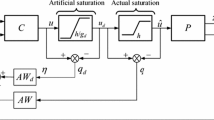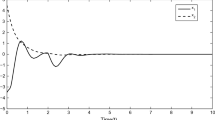Abstract
Traditional anti-windup compensators are designed for activation immediately at the occurrence of actuator saturation. Recently, anti-windup compensators were designed for actuation either after the saturation has reached a certain level or in anticipation of its occurrence. In the case of static anti-windup compensators, it has been shown that an anti-windup compensator designed for activation in anticipation of actuator saturation would lead to better performance than those designed for immediate or delayed activation could, both in terms of transient performance and the size of the domain of attraction. More recently, it has been shown that a dynamic anti-windup compensator designed for anticipatory activation would also result in better transient performance than those designed for immediate or delayed activation could. In this paper, we design dynamic anti-windup compensators for the enlargement of the domain of attraction. These compensators are designed respectively for immediate, delayed and anticipatory activation. We will show by simulation that a dynamic anti-windup compensator designed for anticipatory activation would result in a larger domain of attraction than a dynamic anti-windup compensator designed for immediate or delayed activation could.
Similar content being viewed by others
References
Astrom K J, Rundqwist L. Integrator windup and how to avoid it. In: Proceedings of the American Control Conference, Pittsburgh, 1989. 1693–1698
Cao Y, Lin Z, Ward D. An anti-windup approach to enlarge domain of attraction for linear systems subject to actuator saturation. IEEE Trans Auto Contr, 2002, 47: 140–145
Edwards C, Postlethwaite I. An anti-windup scheme with closed-loop stability considerations. Automatica, 1999, 35: 761–765
Glattfelder A G, Schaufelberger W. Stability analysis of single-loop control systems with saturation and antireset windup circuit. IEEE Trans Auto Contr, 1983, 28: 1074–1081
J M Gomes da Silva Jr, Tarbouriech S. Antiwindup design with guaranteed regions of stability: an LMI-based approach. IEEE Trans Auto Contr, 2005, 50: 106–111
Grimm G, Hatfield I, Teel A, et al. Antiwindup for stable linear systems with input saturation: an LMI-based synthesis. IEEE Trans Auto Contr, 2003, 48: 1509–1525
Herrmann G, Turner M, Postlethwaite I. Some new results on anti-windup-conditioning using the weston-postlethwaite approach. In: Proceedings of the 43rd IEEE Conference on Decision and Control, Nassau, 2004. 5047–5052
Kahveci N, Ioannou P. Adaptive LQ control with anti-windup augmentation to optimizae UAV performance in autonomous soaring applications. IEEE Trans Contr Syst Technol, 2008, 16: 691–707
Kapila V, Grigoriadis K. Actuator Saturation Control. Basel: Marcel Dekker, Int., 2002
Kappor N, Teel A, Daoutidis P. An anti-windup design for linear systems with input saturation. Automatica, 1998, 34: 559–574
Kothare M, Campo P, Morari M, et al. A unified framework for the study of anti-windup designs. Automatica, 1994, 30: 1869–1883
Mulder E, Kothare M, Morari M. Multivariable anti-windup controller synthesis using linear matrix inequalities. Automatica, 2001, 37: 1407–1416
Saeki M, Wade N. Synthesis of a static anti-windup compensator via linear matrix inequalities. Int J Robust Nonlinear Control, 2002, 12: 927–953
Teel A, Kapoor N. The L 2 anti-windup problem: Its definition and solution. In: Proceedings of the European Control Conference, Brussels, 1997. 120–128
Turner M, Postlethwaite I. A new perspective on static and low-order anti-windup synthesis. Int J Contr, 2004. 77: 27–44
Wu F, Grigoriadis K, Packard A. Anti-windup controller design using linear paramter-varying control methods. Int J Contr, 2000, 73: 1104–1114
Wu F, Lu B. Anti-windup control design for exponentially unstable LTI systems with actuator saturation. Syst Control Lett, 2004, 52: 305–322
Hu T, Teel A, Zaccarian L. Reginoal anti-windup compensation for linear systems with input saturation. In: Proceedings of the American Control Conference, Portland, 2005. 3397–3402
Sajjadi-Kia S, Jabbari F. Modified anti-windup compensators for stable plants. IEEE Trans Auto Contr, 2009, 54: 1934–1939
Sajjadi-Kia S, Jabbari F. Modified anti-windup compensators for stable plants: Dynamic anti-windup case. In: Proceedings of the 48th IEEE Conference on Decision and Control and 28th Chinese Control Conference, Shanghai, 2009. 2795–2800
Wu X, Lin Z. Anti-windup in anticipation of actuator saturation. In: Proceedings of the 49th IEEE Conference on Decision and Control, Atlanta, 2010. 5245–5250
Wu X, Lin Z. On immediate, delayed and anticipatory activation of anti-windup mechanism: Static anti-windup case. IEEE Trans Auto Contr, 2012, 57: 771–777
Wu X, Lin Z. Design of multiple anti-windup loops for multiple activations. Sci China Inf Sci, 2012, 55: 1925–1934
Sajjadi-Kia S, Jabbari F. Multi-stage anti-windup compensation for open-loop stable plants. IEEE Trans Auto Contr, 2011, 56: 2166–2172
Wu X, Lin Z. Dynamic anti-windup design in anticipation of actuator saturation. Int J Robust Nonlinear Control, 2012, in press, DOI: 10.1002/rnc.2887
Hu T, Lin Z, Chen B. An analysis and design method for linear systems subject to actuator saturation and disturbance. In: Proceedings of the American Control Conference, Chicago, 2000. 725–729
Grimm G, Teel A, Turner M, et al. Results on linear LMI-based external anti-windup design. In: Proceedings of the 41st IEEE Conference on Decision and Control, Las Vegas, 2002. 299–304
Author information
Authors and Affiliations
Corresponding author
Rights and permissions
About this article
Cite this article
Wu, X., Lin, Z. Dynamic anti-windup design for anticipatory activation: enlargement of the domain of attraction. Sci. China Inf. Sci. 57, 1–14 (2014). https://doi.org/10.1007/s11432-013-4976-5
Received:
Accepted:
Published:
Issue Date:
DOI: https://doi.org/10.1007/s11432-013-4976-5




